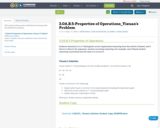
This task provides practice with flawed reasoning with the distributive property.
- Subject:
- Education
- Mathematics
- Material Type:
- Activity/Lab
- Date Added:
- 07/18/2018

This task provides practice with flawed reasoning with the distributive property.
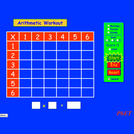
Brush up on your multiplication, division, and factoring skills with this interactive multiplication chart. Three levels and timed or untimed options are available.

In this video segment from Cyberchase, Inez and Lucky figure out how to keep track of the number of clones as they continue to multiply.
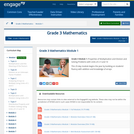
This 25-day module begins the year by building on students fluency with addition and knowledge of arrays.
Find the rest of the EngageNY Mathematics resources at https://archive.org/details/engageny-mathematics.
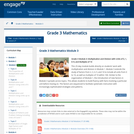
This 25-day module builds directly on students work with multiplication and division in Module 1. Module 3 extends the study of factors from 2, 3, 4, 5, and 10 to include all units from 0 to 10, as well as multiples of 10 within 100. Similar to the organization of Module 1, the introduction of new factors in Module 3 spreads across topics. This allows students to build fluency with facts involving a particular unit before moving on. The factors are sequenced to facilitate systematic instruction with increasingly sophisticated strategies and patterns.
Find the rest of the EngageNY Mathematics resources at https://archive.org/details/engageny-mathematics.
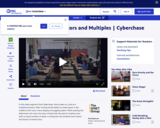
Harry and his students look at various arrangements of classroom desks in this video from Cyberchase.

In this video segment from Cyberchase, Inez estimates whether she has enough jelly beans in her large container to decorate all of the cookies in her batch.
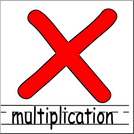
Multiplication practice for third graders.

In this math escape room lesson, students work in teams to solve a series of math puzzles and riddles to "escape" a themed room. Each puzzle is designed to reinforce key math concepts such as fractions, geometry, and basic algebra. As students solve each problem, they receive clues that lead them to the next challenge, promoting critical thinking and collaboration. The activity concludes with a debrief where students discuss the strategies they used and the math skills they applied.

(Nota: Esta es una traducción de un recurso educativo abierto creado por el Departamento de Educación del Estado de Nueva York (NYSED) como parte del proyecto "EngageNY" en 2013. Aunque el recurso real fue traducido por personas, la siguiente descripción se tradujo del inglés original usando Google Translate para ayudar a los usuarios potenciales a decidir si se adapta a sus necesidades y puede contener errores gramaticales o lingüísticos. La descripción original en inglés también se proporciona a continuación.)
Este módulo de 25 días se basa directamente en los estudiantes que trabajan con multiplicación y división en el módulo 1. El módulo 3 extiende el estudio de factores de 2, 3, 4, 5 y 10 para incluir todas las unidades de 0 a 10, así como múltiples de 10 dentro de 100. Similar a la organización del Módulo 1, la introducción de nuevos factores en el módulo 3 se extiende a través de temas. Esto permite a los estudiantes construir fluidez con hechos que involucran una unidad en particular antes de continuar. Los factores están secuenciados para facilitar la instrucción sistemática con estrategias y patrones cada vez más sofisticados.
Encuentre el resto de los recursos matemáticos de Engageny en https://archive.org/details/engageny-mathematics.
English Description:
This 25-day module builds directly on students work with multiplication and division in Module 1. Module 3 extends the study of factors from 2, 3, 4, 5, and 10 to include all units from 0 to 10, as well as multiples of 10 within 100. Similar to the organization of Module 1, the introduction of new factors in Module 3 spreads across topics. This allows students to build fluency with facts involving a particular unit before moving on. The factors are sequenced to facilitate systematic instruction with increasingly sophisticated strategies and patterns.
Find the rest of the EngageNY Mathematics resources at https://archive.org/details/engageny-mathematics.

(Nota: Esta es una traducción de un recurso educativo abierto creado por el Departamento de Educación del Estado de Nueva York (NYSED) como parte del proyecto "EngageNY" en 2013. Aunque el recurso real fue traducido por personas, la siguiente descripción se tradujo del inglés original usando Google Translate para ayudar a los usuarios potenciales a decidir si se adapta a sus necesidades y puede contener errores gramaticales o lingüísticos. La descripción original en inglés también se proporciona a continuación.)
Este módulo de 25 días comienza el año basándose en la fluidez de los estudiantes con suma y conocimiento de las matrices.
Encuentre el resto de los recursos matemáticos de Engageny en https://archive.org/details/engageny-mathematics.
English Description:
This 25-day module begins the year by building on students fluency with addition and knowledge of arrays.
Find the rest of the EngageNY Mathematics resources at https://archive.org/details/engageny-mathematics.
![OREGON MATH STANDARDS (2021): [3.OA]](https://img.oercommons.org/160x134/oercommons/media/courseware/lesson/image/13138_ODE_Math_Logo_2018-H_color_BvjqVNy.png)
The intent of clarifying statements is to provide additional guidance for educators to communicate the intent of the standard to support the future development of curricular resources and assessments aligned to the 2021 math standards. Clarifying statements can be in the form of succinct sentences or paragraphs that attend to one of four types of clarifications: (1) Student Experiences; (2) Examples; (3) Boundaries; and (4) Connection to Math Practices.

Ratey pops up when you least expect him. And he can't resist pointing out the rates and "purrportions" in daily life. It turns out that everyday decisions rely on mathematical reasoning about rates.

In this video segment from Cyberchase, Jackie shows Buzz, Delete and Harold how to deal out rounds (or sets) of objects to solve a problem.

This task is a follow-up task to a first grade task: http://www.illustrativemathematics.org/illustrations/466.
On the surface, both tasks can be completed with sound procedural fluency in addition and multiplication. However, these tasks present the opportunity to delve much more deeply into equivalence and strategic use of mathematical properties.